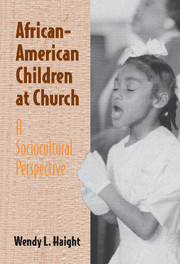Book contents
- Frontmatter
- Contents
- List of Tables
- Acknowledgments
- PART ONE OVERVIEW
- PART TWO PATTERNS OF SOCIALIZATION AND PARTICIPATION
- 4 African-Americans in Salt Lake City: A Historical and Social Overview
- 5 The Teachers
- 6 Adults' Perspectives on Spiritual Socialization
- 7 Narratives Related during Sunday School
- 8 Socialization and Participation through Storytelling
- 9 Adult–Child Verbal Conflicts
- 10 Other Contexts for Socialization and Participation
- PART THREE RELATIONSHIPS OF RESEARCH AND PRACTICE
- PART FOUR CONCLUSION
- References
- Index
4 - African-Americans in Salt Lake City: A Historical and Social Overview
Published online by Cambridge University Press: 10 August 2009
- Frontmatter
- Contents
- List of Tables
- Acknowledgments
- PART ONE OVERVIEW
- PART TWO PATTERNS OF SOCIALIZATION AND PARTICIPATION
- 4 African-Americans in Salt Lake City: A Historical and Social Overview
- 5 The Teachers
- 6 Adults' Perspectives on Spiritual Socialization
- 7 Narratives Related during Sunday School
- 8 Socialization and Participation through Storytelling
- 9 Adult–Child Verbal Conflicts
- 10 Other Contexts for Socialization and Participation
- PART THREE RELATIONSHIPS OF RESEARCH AND PRACTICE
- PART FOUR CONCLUSION
- References
- Index
Summary
In this chapter, I place children's religious experiences at First Baptist Church within the broader historical and social context of Salt Lake City, Utah. As Ronald Coleman (1981) observed:
For Black Utahns, the African-American church has historically been the single most important institution in the state. It has served as a place of refuge in the most difficult times and many of the Black religious leaders have been ambassadors of good will for the African-American, and larger, community. (p. 2)
A BRIEF HISTORY OF AFRICAN-AMERICANS IN UTAH
African-Americans have played a role in the development of Utah since the early nineteenth century. James Beckwourth, for example, trapped, hunted, and explored in Utah in the early nineteenth century (1824–26). He fought in the Seminole and Mexican wars, joined the California gold rush, and lived with the Crow Indians. His published dramatic accounts of his experiences have provided valuable historical information (Coleman, 1981).
Permanent African-American settlements were established in Utah with the immigration of the first Mormon pioneers in the midnineteenth century. Indeed, three African-American men accompanied Brigham Young on his journey to Utah in 1847. Both enslaved and free blacks continued to accompany the Mormon pioneers to Utah. The 1860 census counted 59 African-Americans in Utah, 29 of whom were enslaved (Mathews & Wright, 1994). Yet, relatively little is known about the African-Americans who helped to settle and develop Utah.
- Type
- Chapter
- Information
- African-American Children at ChurchA Sociocultural Perspective, pp. 51 - 58Publisher: Cambridge University PressPrint publication year: 2001



